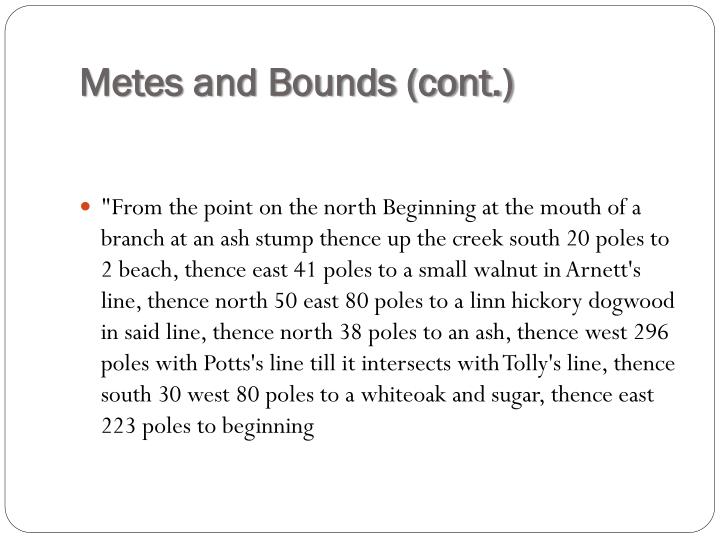

This means that metes can be described as north, south, east, or west. A property’s direction may be as simple as a compass point, or the direction that each point of the property faces. Metes can also be found by determining a plot of land’s direction. “Metes” are a piece of property’s boundary lines, as determined by measuring its “straight runs.” A straight run is the distance between two points. 70 W (range 70 west) of the 6th PM (the sixth principal meridian, a north–south reference line) in ABC County, Colorado, bears N 45° W 1,320 feet, at which point of beginning an iron stake has been placed thence south 600 feet to a point also marked by an iron stake thence N 45° W 700 feet to a large oak tree thence northeasterly to the point of beginning.” “Beginning at a point from which the north quarter corner of Section 4, T. While the system is still used today, technology has greatly improved upon its associated tools and measurements.Ĭonsider the following example of metes and bounds description, which describes a roughly triangular-shaped piece of property using distance, direction, and compass points, as well as manmade markers that were used to mark out the property for future reference: You don't mention where you are, but in some places and circumstances, generating metes and bounds descriptions for such records can only be done by certain people (licensed surveyors) and may potentially open you up to a host of liability issues.A metes and bounds description of a piece of land is referred to as its “legal description,” as opposed to being distinguishable by a mere street address or lot number. Basically you import that shape, but all the information you're looking for is already tracked in a parcel fabric.Īs an aside, you mention this is for 'local government legal requirements'.

The second method involves using Parcel Fabrics and is considerably more complicated.
#Where did metes and bounds originate how to
Getting points from vertices and adding coordinate attributes to those points is covered at other questions, as are getting the distance/direction attributes on the lines (which also uses the COGO toolbar and is discussed at How to display survey calls using the traverse tool?). You'll need two different feature classes, one for points and one for lines. Since you're wanting attributes on lines and points, you'll need to break the polygon down as ed mentions. Note that the start coordinate will be based on the polygon creation, and that it won't cover the commencement calls to that PoB.


This will create a list of calls for the polygon which you can then save to a text file. Launch the Traverse tool on the COGO toolbar, then right-click in the call box and choose Load Traverse from Sketch. In edit session, double click the polygon in question to enter vertex editing mode. If you're using a Standard or Advanced license, then yes, you can easily convert a polygon into a metes and bounds description via one of two methods.įirst relies on the COGO tools, specifically Traverse.


 0 kommentar(er)
0 kommentar(er)
